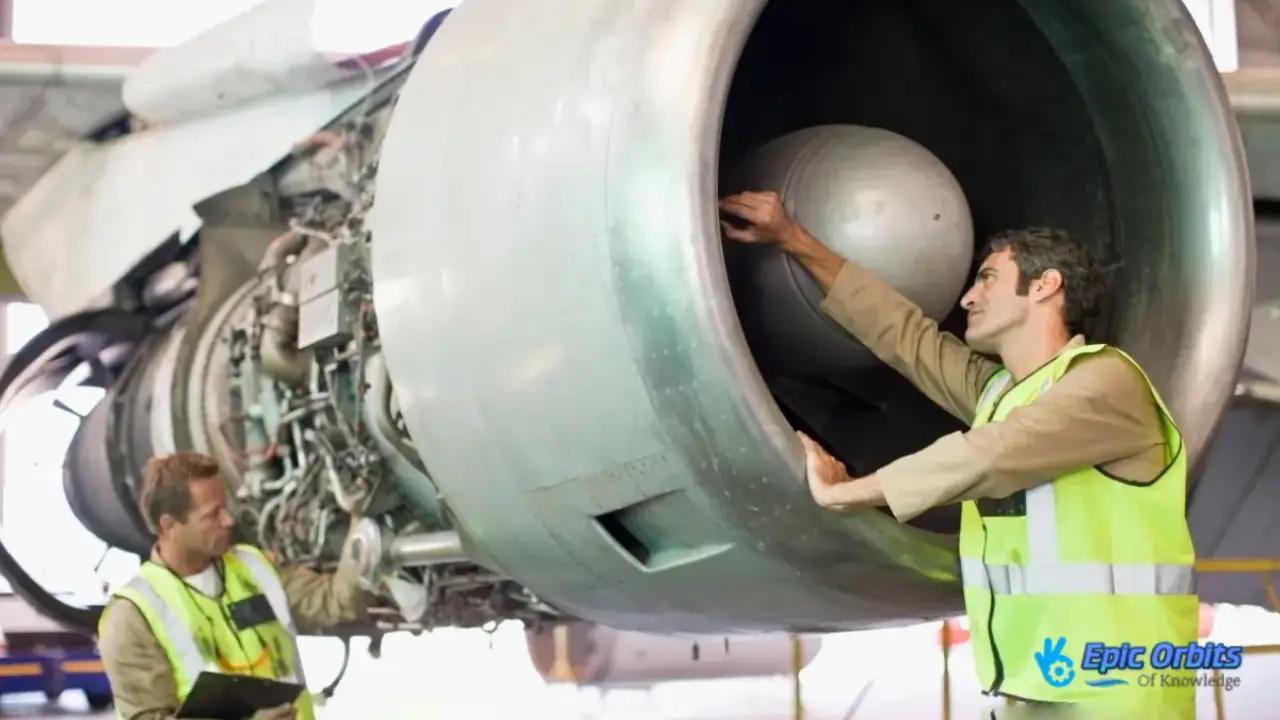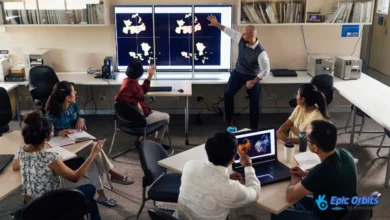Aerospace engineering Career Guide
Aerospace engineering is a field that focuses on the design and development of aircraft, spacecraft, satellites, and missiles.

Aerospace engineering goes beyond the practical development and manufacture of aircraft and spacecraft; it also encompasses understanding the complex mechanisms that enable these technological marvels. It plays a fundamental role in everything from jet aircraft to global travel to the exploration of distant worlds.
Some of the most exciting developments of our time come from aerospace engineering; examples include the rockets launching people into space and the jet engines running commercial airplanes.
This field continuously pushes the boundaries of feasibility, combining creativity and science. Therefore, if you’ve ever been fascinated by how people achieve the unachievable, aeronautical engineering offers the solution to such mysteries.
The Evolution of Aerospace Engineering
Aerospace engineering has a rich past full of remarkable successes. Early flying experiments began it all; pioneers like the Wright brothers made the first successful powered flight in 1903. This monument marked the start of contemporary flying. From jet engines to supersonic flight to space exploration, aerospace engineering education has evolved remarkably over time.
Important players in this field have included NASA, which pioneered space exploration, and Sir George Cayley, often described as the “father of aviation,” who greatly advanced aircraft engineering. Aeronautical engineering keeps stretching the boundaries of what is feasible, from the first moon landing to the most current Mars missions.
branches of aeronautical engineering
There are various disciplines of aerospace engineering, each with particular applications and specializations. Knowing these sides helps you to cover the whole field. Attending top institutions for aerospace engineering may provide a strong basis and offer doors to expanded knowledge and job possibilities for those eager to explore further in these fields.
- Engineering in Aviation: The design and development of both fixed-wing (airplanes) and rotary-wing (helicopters) aircraft fall under aviation engineering. Engineers in this field work on everything from military aircraft to commercial planes, ensuring that these vehicles are safe, efficient, and capable of operating in a variety of environments.
- Astronautic Technical Design: Astronautical engineering is the study of spacecraft and related systems. Whether it’s launching space shuttles, placing satellites in orbit, or planning trips to distant worlds, this discipline is all about exploring space. Aeronautical engineering primarily concentrates on aircraft within the Earth’s atmosphere, whereas astronautical engineering tackles space-related challenges. Engineers in this field have to be creative and exact to meet the difficulties of working in a hostile environment like space.
- Aerospace Engineering: The wide term “aeronautical engineering” refers to both spacecraft and aircraft design. It is a multifarious and important part of aeronautical engineering, as it covers the study of aerodynamics, propulsion, and structures. Working on anything that travels through the Earth’s atmosphere and beyond, aeronautical engineers
Important ideas and guiding concepts in aerospace engineering
There are just a few fundamental ideas and concepts guiding aerospace engineering. Anyone interested in the field of aeronautical engineering must first grasp the foundations of the ideas involved.
- Aerodynamics is the study of air movement around things, most especially in flight. Since it determines an aircraft’s flying efficiency, it is a fundamental component of aircraft engineering. To better the form and performance of airplanes and spacecraft, engineers investigate the forces of lift, drag, and propulsion.
- Generating the thrust needed to propel an aircraft or spaceship is known as propulsion. Achieving and sustaining flight depend critically on propulsion systems—which include jet engines, rocket engines, and propellers. To raise the performance of aeronautical vehicles, engineers are developing stronger and more efficient propulsion systems.
- Structures: Aircraft and spacecraft have to be strong, lightweight, and stress-bearing capable. Focused on the design and analysis of these buildings, engineers in this sector guarantee their safety and longevity. In this field of aeronautical engineering, advanced materials such as composites are quite essential.
- Systems of guidance and control allow aeronautical vehicles to be steered and controlled. These technologies guarantee airplanes and spacecraft remain on their intended paths and react appropriately to orders. Modern technologies and algorithms developed by engineers guarantee flying stability and control.
Occupational Routines in Aerospace Engineering:
Careers in aerospace engineering provide numerous possibilities in manufacturing, design, and research. Prospects for aerospace engineering jobs in Germany and Switzerland seem outstanding. For engineers working on creative aircraft concepts, companies like Accelleron in Switzerland and Deutsche Aircraft in Germany have fascinating prospects.
- Research & Development: Research and development by aerospace engineers helps create new technologies and improve current ones. This can include designing the next aircraft, developing more effective aerodynamic propulsion systems, or investigating new aeronautical engineering materials and designs. R&D is the career for people who appreciate facing challenging tasks, as it is where innovation takes place.
- Design and engineering play a major role in driving aerospace endeavors. Working on everything from the basic design of an airplane to the precise engineering of individual components, engineers in this profession take ideas and make them reality. This discipline calls for imagination, accuracy, and a strong grasp of basic aircraft engineering principles.
- Production and Manufacturing: Once a design is polished, it has to be constructed. Manufacturing- and production-based aerospace engineers ensure that spaceships and airplanes are manufactured to stringent criteria. This includes managing the whole production process from beginning to end, guaranteeing quality control, and using cutting-edge manufacturing technologies and materials.
- Control of Testing and Quality: In aviation engineering, safety is paramount; testing and quality control help to guarantee that everything runs as it should. These engineers rigorously test airplanes and spacecraft, looking at performance and spotting any issues. This posture calls for meticulousness and a commitment to quality.
- Aerospace Consultancy: For those with expertise and skills, aerospace consultancy offers a different professional route. On aeronautical projects, consultants advise and provide ideas to businesses, governments, and organizations. Whether they are helping with the design of a new aircraft or offering guidance on regulatory compliance, aerospace consultants are integral to the vibrant trends in the aerospace sector.
Aerospace Engineering Perspectives and Difficulties
A dynamic discipline that continuously faces challenges and promotes invention is aerospace engineering. Here is a closer view of some of the present difficulties and fascinating developments influencing the future.
- In sustainable aviation: Developing more environmentally friendly aircraft is one of the toughest projects in aeronautical engineering. Engineers are concentrating on developing fuel-efficient engines, looking at alternative fuels, and constructing electric and hybrid planes as worries about climate change become more real. The shift to sustainable aviation is essential for reducing the negative impact of air travel and ensuring the future of the industry.
- Space Discovery: Still an intriguing area of aeronautical engineering is space exploration. Setting new benchmarks with goals for Mars, the Moon, and beyond, engineers are Important prospects include developing reusable rockets, enhancing satellite technology, and looking at human settlement of other planets. Despite the great challenges, these discoveries provide significant advantages and developments in space travel.
- Modern Products: Using new materials is changing aeronautical engineering. Lightweight, composite solid materials increase airplane and spaceship efficiency, hence producing faster and more robust vehicles. The aerospace industry is a fascinating area of development, as continuous investigation into new materials and manufacturing processes is stretching the boundaries of performance.
Composites’ Use in Aerospace Engineering
In airplane design, composites are becoming quite indispensable. Their specific characteristics qualify them for many uses in aeronautical engineering. Let’s examine what composites are, how the aerospace industry uses them, and what advantages they provide.
Comprising two or more basic elements with different physical or chemical characteristics, composites are materials. Joining these components creates a composite with qualities different from each individual component.
Because of their lightweight but strong qualities—which provide a high strength-to-weight ratio—composites are being employed in aircraft engineering. For usage in aircraft and spacecraft designs where weight and strength are critical, this makes them perfect.
Composite airplane and spacecraft parts include airframes, wings, propellers, and interior components. Composite materials’ modest weight enables the vehicle to reduce its overall weight, thereby enhancing performance and fuel efficiency. For instance, contemporary commercial aircraft such as the Boeing 787 Dreamliner and Airbus A350 heavily utilize composite materials in their construction. Over the lifetime of the airplane, these materials increase performance and aid in saving expenses.
Using composites rather than conventional materials like metals offers several benefits. Composites enable military and commercial aircraft to achieve higher fuel economy. Composites excel in strength, durability, and corrosion resistance. Composites also help to save money, as they have a longer lifetime than conventional materials and need less maintenance.
Composites are essentially transforming aircraft engineering by enabling lighter, stronger, and more efficient vehicles.
Aerospace Engineering Technology Innovations Made Possible by Composites
The use of composites in aviation engineering is always growing, as technological developments and discoveries help define the direction of the sector.
From the past to now, and even presently, aeronautical engineering has seen a notable development. Recent developments in aeronautical engineering connected to composites include improved manufacturing methods, 3D printing of composite components, and the identification of novel composite materials.
Previously difficult to create using conventional techniques, 3D printing allows the manufacturing of complex composite structures. In aircraft engineering, this technology is extending design and performance choices. Large-scale manufacture of premium composite components made possible by advanced manufacturing processes drives higher use in the aerospace industry.
Particularly considering the growing usage of composites, aviation engineering has strong future prospects. We should anticipate far more creative uses of composites in aviation engineering as technology develops. This might include the development of next-generation aircraft that are lighter and faster than ever before and more efficient.
Conclusion
Combining vision, ingenuity, and technical knowledge, aerospace engineering creates vehicles that let us soar beyond the earth and beyond. From the inception of flight to the current advancements in aerospace engineering, the focus has consistently been on expanding the boundaries of what is possible.
This thorough review of aeronautical engineering examined the principles, uses, and developments in aircraft design. We examined the many branches of the discipline, followed its past, and spoke about the important concepts guiding it. We also looked at the challenges and discoveries that will define its future, especially with regard to the use of creative materials like composites.
For those drawn to aeronautical engineering, research, design, manufacture, and consultancy provide intriguing opportunities. This line of work advances space exploration, communication, and transportation as well as invention. Aerospace engineering is a trip of discovery and invention, not just a job. The field develops with the possibilities also changing. Whether you work on the newest aircraft or investigate space, aerospace engineering offers a unique and fascinating professional path.



